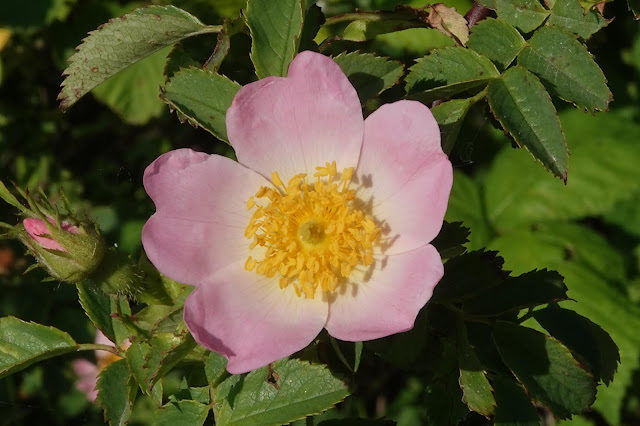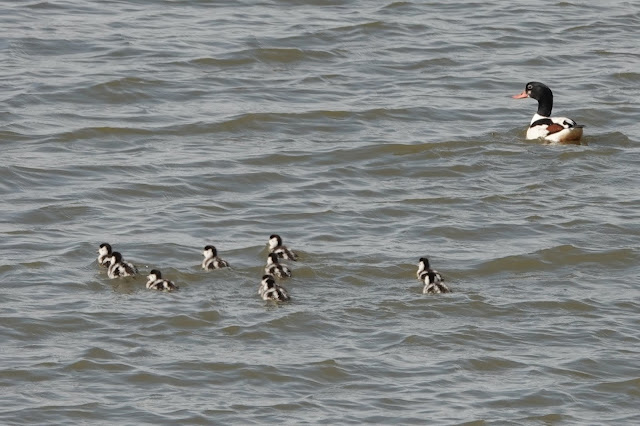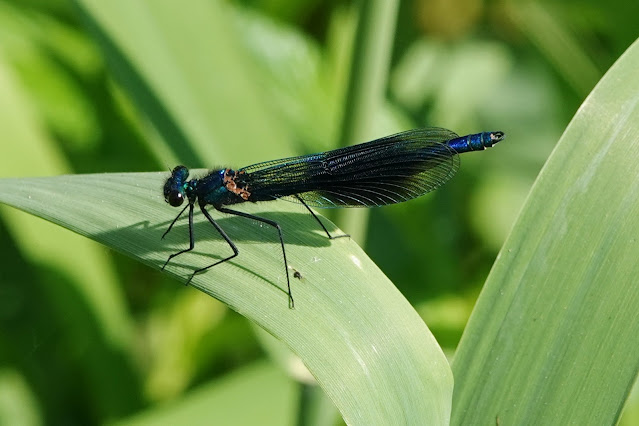Today was a car day which meant that I had to drop my
Roomster off in Rainham early doors leaving me to head off and explore for
several hours. I retraced my route back to Rainham Tesco, past Rainham Hall and then over CTRL and
onto Rainham North.
There were Sedge and Cetti’s belting out as I walked down
and I could hear Song Thrushes and numerous Whitethroats while the verges were burgeoning
with flowers now although the reappearance of Giant Hogweed in some sizeable
clumps was worrying.
 |
Giant Hogweed - feels like it is propping up the pylon
|
 |
Dittander - I think
|
 |
| Comfry |
 |
| Comfry |
There were plenty of Bumblebees in attendance with Common
Carder, Early, Red-tailed and Buff-tailed with the Hawkweeds and Tufted Vetch
being particularly popular. Oedemera nobilis dotted purple Salsify and yellow
Goats Beard like little iridescent green jewels and there were a few blue
Damsels drifting around.
 |
Queen Early Bumblebee - Bombus pratorum
|
 |
| Hawkweed |
 |
Tufted vetch
|
 |
| Oedemera nobilis |
Rainham West was much the same but I did find two male
Cuckoos and a showy Cetti’s Warbler. I
was on the listen for Marsh Warblers but I do not think we have been graced this
year.
 |
| Cetti’s Warbler |
 |
| uckoo |
It was good to find Water Dock thriving in the one section
of the channel alongside the silt lagoons that I could see into and even the
dumpy little Horse Chestnut was still flowering and looking very healthy!
 |
Water Dock
|
 |
Pink Horse Chestnut
|
 |
Towering Hemlock
|
The Dog Roses were blooming in every shade of pink through
to white and Cinquefoil crept across the path with yellow Rockrose-like
flowers. Down at the Barges the Thames was still coming in slowly but was very
tranquil and I could see where each diving Common Tern hit the water. I could hear Oystercatchers and a brood of
Shelduck were on the mud just beyond Tilda where the Feral Pigeons were sheltering
on the jetty put of the strong sun.
 |
Dog Rose
|
 |
| Cinquefoil |
 |
| Shelduck |
The scrappy piece of path past the factory is always covered
in flowers and I suspect the pulverised rubble that makes up the area is what
makes it so good. There were swathes of
Oxeye Daisy and Hedge Cranesbill and the Dogwood flowers were being attended by
countless Buff-tails and Honey Bees along with e few Helophilus pendulus and
Parhelophilus sp and a plump Tachina fera.
 |
Oxeye Daisy
|
 |
Wild Carrott
|
 |
| Poppy |
 |
| Bracken |
 |
Tent of Spindle Ermine?
|
 |
Buff-tail on Dogwood
|
 |
Parhelophilus sp
|
 |
Tachina fera
|
I found but lost a fine Crab Spider on a Daisy but a Malachius
bipustulatus was a little more obliging. Holly and Common Blues zipped around
and a Brimstone posed nicely for me. I think that the lilac Scabious that I
found is Small rather than Field and there was a good patch of Purple Toadflax. A sollitary Crossbill flew over calling.
 |
| Harlequins |
 |
Purple Toadflax
|
 |
| Scabious and Malachius
bipustulatus |
 |
| Brimstone |
 |
Common Blue
|
The clump of Tansy has come up well again and the unopened
heads look like pale broccoli florets! The Oxeye Daisies followed me all the
way back to the road and I found a patch of Kidney Vetch and pink Yarrow
amongst them along with a very fine Mother Shipton with her long wobbly nose.
 |
| Tansy |
 |
| Tansy |
 |
| Viper's Bugloss |
 |
| Yarrow |
 |
the Daisy loving Dichrorampha alpinana
|
 |
Mother Shipton
|
 |
Kidney Vetch
|
I came back up to Tesco and from the Red Bridge over the
Ingrebourne there were over a dozen Banded Demoiselles flouncing around on the
Branched Bur-reed below. The females
were particularly green and shiny.
 |
Banded Demoiselles
|
I made it as far as the main lake beyond the Albion Pub
where the Black-necked Grebes bred all those years ago and spent a wonderful
hour watching dragonflies around the margins. Black-tailed Skimmers were
literally emerging and shimmer winged tenerals regularly fluttered past me and
into the Vetches to finish off the drying process. One Emperor was not looking too great and one
of her forewings looked unlikely to unfurl all the way.
 |
| Emperor |
 |
Black-tailed Skimmer
|
Down at the edge I lurked at the various fisherman spots and
was rewarded with some great views of Four Spot Chaser along with single Hairy Hawker
and Broad Bodied Chaser and Common Blue, Blue tailed, Azure and Red-eyed
Damselflies. It felt like summer.
 |
Four Spot Chaser egg laying sequence - you can see the eggs in the top shots
|
 |
Red-eyed Damselfly
|
The best was still to come when a pair of green eyes stopped
in front of me but it was too small to be a Norfolk Hawker. It was a male Downy
Emerald, a species I have only seen in Epping Forest in Essex but I seem to
recall that Ian Plume photographed one in the Valley the year before last.
 |
Downy Emerald
|
Two males were present but one had this bay sewn up as his
and battled all comers until a big Hawker came in and nearly snaffled it. But
it was not just any big dragonfly but a fine male Lesser Emperor with sky blue
sadle glowing on each turn. I saw him a few times but never long enough to get
the camera up.
 |
| Downy Emerald |
Two female Scaeva pyrastri were caught egg laying – my first
of the year but there was generally a dearth of flies.
 |
Eristalinus sepulchralis
|
 |
Scaeva pyrastri
|
 |
| Scaeva pyrastri |
 |
Helophilus pendulus
|
 |
Larionoides cornutus
|
I apologised to the Swans and Greylag family that I had no
leftovers and started to head back to pick up my car from Brian. It was now very warm and I was glad to get in
the car and head towards East Tilbury with the windows down.
 |
| Whitethroat |
 |
| Whitethroat |
It always seems to take and age to get to Coalhouse Fort from Rainham
but soon I was heading out along the concrete river wall path where I spent
many a day checking through the waders over the high tide on the silt lagoons
or watching flock of Lapland and Corn Buntings feeding in the inland fields. It is all very different now and the old
silts have become a botanically rich grassland and it was the Orchid meadow
that I was after. It was at the far end but the wow on seeing a carpet of lilac
and purple scattered amongst the Yellow Rattle was worth the walk in the sun.
However I became very confused very quickly. I have barely seen an open Common Spotted
Orchid in Kent and yet here there were hundreds of neat little pale triangles
and amongst them were some towering cigar shaped ones that I presumed were Marsh. I gingerly approached, being very careful
where my feet went, to get a closer look but it was not till I got home that I
think I was able to get a handle on what was going on.
 |
Common Spotted, Marsh types and almost spent Green Winged
|
 |
Common Spotted
|
Some of the cigar shaped ones appear to be Southern Marsh
but most appear to feel like Marsh Orchids but have Common Spotted lip patterns and shape
thus making them hybrids. I had been
told about them down here but just surprised how impressive and vigorous they
were.
 |
Common Spotted
|
 |
Pretty sure these two are Southern Marsh
|
 |
| Whereas all these Marsh types show Common Spotted lip patterns and spotty or even stripy leaves- I think! |
If my labelling is incorrect please do message me and let me
know. Amongst them were what I am sure
were the nearly spent spikes of Green Winged Orchid but I was so distracted by
the grandeur of the hybrids that I never took a close up shot!
I looped back along the riverside of the path getting my fix
of a Thames Barge with the sails up and finding several Green Hairstreaks and
Wall Browns along the path. Some years I
never see a Green H but this year I can’t miss them!
 |
Tatty Wall Brown
|
 |
Green Hairstreak
|
 |
Burnet Companion
|
 |
Grass Vetchling
|
 |
Interesting Clover
|
There were lots of Whitethroats in song but no Gropper for
me but I was happy with a huge orange Queen Brown Banded Carder Bee trying to
hang onto the already drooping flowers of Tufted Vetch.
 |
Brown Banded Carder Bee - Bombus humilis
|
 |
| Brown Banded Carder Bee - Bombus humilis |
I was home and happy by half two but looking at those Orchid
pictures only confused me further so after dinner it was a short run out to
Holborough Marshes to look for some Early Marsh Orchids that Ian had directed
me too. His directions were spot on and
I soon found two almost spent spikes in
a glorious meadow that was also brimming with Common Spotteds in various shades
and the first flowers of Yellow Flag dotted between great billowing clumps of Hemlock
Water Dropwort. A Spitfire roared
overhead.
 |
Common Spotted
|
 |
Early Marsh
|
 |
| Hemlock
Water Dropwort |
 |
Yellow Flag
|
I called in on my Peregrines on the way home and was
delighted to see that my two fluffy white young were moving around and look
fully feathered. They were making so
much noise and tucking into dinner with aplomb while mum sat nearby being
equally vociferous and I actually think she was trying to persuade them to take
to the air.
A most pleasing way to end my day...




















































































































No comments:
Post a Comment